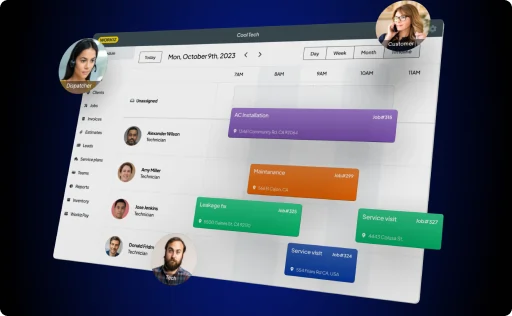What can we say? America loves staying comfortable indoors, whether that’s air conditioning at the perfect temperature in the summer or just the right about of heat to keep us toasty come wintertime.
If you’ve decided to start your own HVAC business, now is an excellent time. There continues to be an increased demand, and competition is fierce. What’s particularly great about diving into the HVAC industry is you can start as small or as big as your startup budget can provide. Part-time HVAC owners can bring in a side income with their full-time job, growing as they bring in more revenue and more long-term clients.
By proactively planning their next steps, business owners can meet their goals more efficiently, such as attracting more customers, fewer job cancellations, and an overall growth perspective. The best way to plan for your business is to have a written, formal business plan.
The importance of having a business plan in the HVAC industry
Your HVAC business plan is a formal document that you’ve created that outlines who your business is now and where you want your business to be in the future. It’s more than just sharing your goals. It’s developing a step-by-step outline of how you’re going to achieve them and what you need to get there.
As you grow your business, you can look back on your business plan as a guide to where you should focus your efforts, especially if you hit an unexpected slump. With an effective business plan, you’ll be able to expect the unexpected more quickly and take the proper measures without any wasted downtime.
Not only is your HVAC business plan a handbook of your business, but it’s also a huge asset when your company is applying for investments or funding. Investors will be able to see the map you’ve laid out and be more likely to decide in your favor. It’ll also give you an idea of just how much money you need investors to finance. The last thing you want is to ask for too little when it was probable that you could have attained more.

How to write an HVAC business plan
Some of the most successful businesses in the HVAC industry have created their in-depth, impressive business plans from a template. We’d be willing to believe that some reputable brands have started by finding a free business plan template from a reliable website like Workiz and used it to make their plan their own.
Your HVAC business plan doesn’t need to read like a resume, where there’s only one way to do it, although structured paragraphs and subheadings will make it easier to read and refer to. There are some key components you should consider including to ensure you cover every area needed to promote your business and reach your goals.
- Cover page
- Executive summary
- Business overview
- Startup Summary
- List of HVAC services & Prices
- Market analysis
- Business operations
- Marketing and Sales Plan
- Financial plan
- Summary
Cover page
Your cover page will outline the basic information about your business. This includes your business name, address, your name, your logo, branding, etc. Think of it as an introduction to your business.
Executive summary
Your executive summary should only be one page that outlines what a reader can expect to see throughout the rest of your business plan. It acts as an aspect and summary highlights the key information geared toward whoever is reading your business plan. It should include the essential facts included in your business overviews, such as the history of your business and your mission statement. In many cases, you can change your executive summary depending on whether the reader is a potential investor or a member of your team.
The HVAC executive summary can include the amount of money you hope to have invested or what sets your company apart from the competition.
Business overview
Your business overview will provide the foundation of your business. It will spotlight your company’s mission, values, purpose, and vision. It outlines the structure of your business and the roles of important stakeholders and key players. It also includes the legal structure of your HVAC company (sole proprietorship, partnership, or corporation). If you are a corporation, it will include your registered business name and number as well as your corporate number. Here is where you can also highlight your business goals.
Startup summary
Your Startup summary can be a key section of your business plan for potential investors. It’s crucial for business owners who are starting up from scratch and want to outline the tools and equipment they need, the costs involved, and the prices they will need to charge to break even in the first year or two. Your startup costs can include items as simple as uniforms to large capital assets such as a truck.
List of HVAC services & prices
Under this section, you will list the services your HVAC company provides. Before creating this list, you will likely have researched the industry, gotten an idea of what your competitors are doing, and found some gaps your business can fill. You can also outline the price of each service, whether it’s hourly or by the job, etc.
Market analysis
Your market analysis should include a detailed description of who your customers are and their needs and demographics. If you haven’t had the opportunity to provide your services to customers yet, that’s okay. In this area, it’s more about the research you’ve done to get an idea of how you want to position yourself in the market. For example, you will list the age, gender, income, area of a particular city, etc. What makes this audience unique, and what makes up their needs and wants?
You can also outline who your competitors are in this section. What services are they providing that you aren’t? What type of customers are they attracting? How large is their team, and are they charging similar prices for their services? This area, of course, will change as you and your competitors change.
Business operations
This section dives deeper into the “how” of your business. It will outline what equipment you own or rent, the software, and hardware, such as laptops and smartphones, and the applications downloaded onto them, as well as the administrative side of your business. You can list your employee roles (including your own), salaries, invoice processes, tax processes, and more.
Don’t leave gaps, as the more information you provide in this section, the more legitimate your business will be to investors. It proves you’ve put in all the work necessary and are serious about your brand’s growth.
Other sections you may choose to include are both your short-term and long-term assets.
Marketing and sales plan
Typically your marketing plan is separate from your business plan. In this section, however, you can outline a few strategies you have in mind to start bringing in new customers. You can also outline your sales funnel and the steps your potential customers will take to acquire your services. Much of your marketing and sales plan can include your focus on building a landing page or website and developing a base following on local social media.
Financial plan
Your financial plan is the most vital component of your HVAC business plan, especially if you’re not already bridging in a supportable revenue stream. This section should include what assets you already have, the debt you already owe, and any projected income you are relying on receiving in the near future (think expenses, revenue, outstanding invoices, bank funding, etc.) It would be best to outline your financial goals in as much detail as possible and why. Provide a budget for the next few years based on your sales forecast.
Summary
Your summary should be simple. Give a brief overview of what was just covered without repeating everything said. You should also retake this opportunity to achieve your “ask.” If a potential investor is reading, you want to make it as straightforward as possible how you want their help. Sometimes investors will offer to review your business plan solely to get an idea of who you are and what your business goals will be. If you don’t include the fact that you’re open to investors, they could simply say “looks good” and move on to another project.
Click here to download our free HVAC business plan template, including critical elements you’ll need to maximize the success of your business. Simply go to the three dots icon on the right upper bar menu and hit “Download” to print the file and fill it in.

Final thoughts
It’s important to remember that you don’t need to get swamped by the idea of perfection. If your business is brand new, your plan will likely need only contain the basics. As you grow and get an idea of where your business is heading, that’s when you can adapt and change your HVAC business plan to meet the needs of your clients and your business.
The HVAC industry isn’t disappearing as long as we need homes to live in. Building a business plan that can act as a handbook to success curated by yours truly can truly help you stand out from your competitors, bring in new clients, and reduce the risk of cancellations. It’s one of the many tools you should have with you as you dive into life as a business owner.
What are some other handy tools entrepreneurs in the HVAC industry can utilize? You can power your business with the integrations available from Workiz. Manage everything from one platform and allow yourself more time to focus on what really matters. HVAC teams using Workiz secure more recurring jobs all year round. Reach out for a conversation today.









